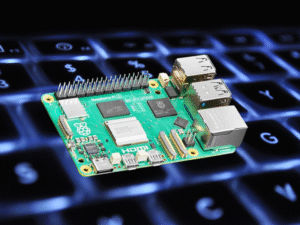
Exploring the Raspberry Pi 5
The Raspberry Pi 5, released on October 23, 2023, is the latest flagship single-board computer from the Raspberry Pi Foundation, delivering a significant leap in performance over its predecessors. This versatile device is a favorite among hobbyists, educators, and professionals for projects ranging from home automation to retro gaming. In this blog post, we’ll dive into the Raspberry Pi 5’s memory options, processing speed, average price, Raspberry Pi 5 power requirements, Raspberry Pi 5 accessories, and Raspberry Pi 5 dimensions, showcasing why it’s a game-changer for tech enthusiasts.
Exploring the Raspberry Pi 5 Memory
The Raspberry Pi 5 is available in two memory configurations: 4GB and 8GB of LPDDR4X-4267 SDRAM, with 1GB and 2GB variants planned but not yet released as of April 2025. The 8GB model is ideal for memory-intensive tasks like running virtual machines, hosting servers, or compiling large codebases, while the 4GB version suits lighter applications such as media centers or IoT projects. The high-speed LPDDR4X memory ensures efficient multitasking, making the Pi 5 a robust platform for diverse use cases. For users planning heavy workloads, investing in the 8GB model is recommended to future-proof their projects.
Processing Power: How Fast Is the Raspberry Pi 5?
The Raspberry Pi 5 is powered by a Broadcom BCM2712 2.4GHz quad-core 64-bit Arm Cortex-A76 CPU, paired with a VideoCore VII GPU supporting OpenGL ES 3.1 and Vulkan 1.2. This setup delivers 2-3 times the performance of the Raspberry Pi 4, with benchmarks showing CPU scores around 1,500-2,000 on Geekbench 5 (compared to the Pi 4’s ~800). The improved architecture and clock speed enable faster processing for tasks like video encoding, machine learning inference, and emulation of demanding retro games. The GPU’s enhanced capabilities also support dual 4K60 displays via twin micro HDMI ports, making the Pi 5 a powerhouse for multimedia applications. However, sustained high-performance tasks generate more heat, requiring active cooling for optimal operation.
Average Price of the Raspberry Pi 5
The Raspberry Pi 5 maintains the Foundation’s commitment to affordability. The 4GB model retails for $60, while the 8GB model costs $80. Prices may vary slightly due to regional taxes or retailer markups, and accessories like cases or power supplies can add to the cost. For context, the Raspberry Pi 500, a keyboard-integrated variant with 8GB, is priced around $96. Given its performance, the Pi 5 offers exceptional value, especially for users upgrading from older models. Availability has stabilized since launch, but checking authorized resellers like CanaKit or PiShop ensures you get genuine hardware at standard prices.
Raspberry Pi 5 Power Requirements
The Raspberry Pi 5 power requirements are more demanding than previous models due to its enhanced performance. It requires a 5V/3A USB-C power supply (15W minimum) for stable operation, compared to the Pi 4’s 5V/2.5A recommendation. The official Raspberry Pi 27W USB-C Power Supply ($12) is recommended, as it can deliver up to 5.1V/5A, supporting power-hungry peripherals via the Pi 5’s USB 3.0 ports. Under light loads, power draw is around 5-7W, but intensive tasks with peripherals can push it to 12-15W. Using an underpowered supply risks instability or undervolting warnings, so investing in a quality power adapter is critical for reliability.
Raspberry Pi 5 Accessories
To maximize the Pi 5’s potential, Raspberry Pi 5 accessories are essential. Key accessories include:
- Active Cooler ($5): A clip-on fan and heatsink to manage heat during intensive tasks.
- Official Case ($10): A sleek enclosure supporting the Active Cooler and providing port access.
- MicroSD Card (16GB+): For running Raspberry Pi OS Bookworm, the recommended OS.
- RTC Battery ($5): Powers the new real-time clock for offline timekeeping.
- PCIe HATs: For adding NVMe SSDs or other expansion boards via the new PCIe 2.0 interface.
These accessories enhance functionality and ensure optimal performance, especially for advanced projects like NAS setups or robotics.
Raspberry Pi 5 Dimensions
The Raspberry Pi 5 dimensions remain compact, measuring 85.6mm x 56.5mm x 17mm (L x W x H, including ports), identical to the Pi 4’s footprint. This makes it easy to fit into existing enclosures or custom builds. The board’s layout has been updated with a fan header, dual camera/display connectors, and a power button, but its size ensures compatibility with most Pi 4 cases, though some may need minor adjustments for new port placements.
Conclusion
The Raspberry Pi 5 is a remarkable evolution, offering 4GB or 8GB memory, blazing-fast processing with a 2.4GHz Cortex-A76 CPU, and an affordable price of $60-$80. Its Raspberry Pi 5 power requirements demand a 5V/3A USB-C supply, and Raspberry Pi 5 accessories like coolers and cases enhance its versatility. With compact Raspberry Pi 5 dimensions, it’s perfect for hobbyists and professionals alike. Whether you’re building a smart home hub or a retro arcade, the Pi 5 delivers unmatched performance for the price. Get yours and start creating today!
Burstingblog.com participates in the Amazon Services LLC Associates Program, an affiliate advertising program. Some links on this site are affiliate links, and we may earn a small commission on purchases made through them, at no extra cost to you. This helps support our site. We only recommend products we trust, and our content remains unbiased.